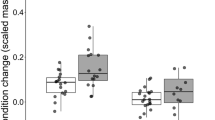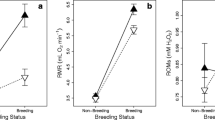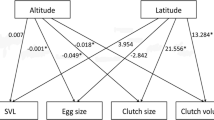Abstract
Prenatal effects caused by the maternal environment during gestation are known to contribute to the phenotype of the offspring. Whether they have some adaptive value is currently under debate. We experimentally tested the existence of such a maternal effect (food availability during gestation) on dispersal of offspring in the common lizard (Lacerta vivipara). Pregnant females were captured and kept in the laboratory until parturition. During this period, females were offered two rates of food delivery. After parturition, we released mothers and offspring at the mother's capture point. Dispersal of young was significantly affected by the mother's nutrition. To our knowledge, this is the first evidence of a prenatal effect on dispersal. Offspring of well fed mothers dispersed at a higher rate than those of less well fed mothers. As current hypotheses clearly predict the opposite result, our evidence calls for their reassessment. Dispersers are not always the least fit individuals or those coming from the poorest environments.
Similar content being viewed by others
References
Anderson PK (1989) Dispersal in rodents: a resident fitness hypothesis (Special publication no. 9). American Society of Mammalogists, Provo
Bauwens D, Thoen C (1981) Escape tactics and vulnerability to predation associated with reproduction in the lizard Lacerta vivipara. J Anim Ecol 50:733–743
Begon M, Harper JL, Townsend CR (1990) Ecology: individuals, populations and communities, 2nd edn. Blackwell Scientific Publications, Oxford
Bernado J (1991) Manipulating egg size to study maternal effects on offspring traits. TREE 6:1–2
Brandt CA (1992) Social factors in immigration and emigration. In: Stenseth NC, Lidicker WZ Jr (eds) Animal dispersal: small mammals as a model. Chapman & Hall, London, pp 96–141
Brody MS, Lawlor LR (1984) Adaptive variation in offspring size in the terrestrial isopod Armadillium vulgare. Oecologia 61: 55–59
Clobert J, Perrins CM, McCleery RH, Gosler AG (1988) Survival rate in the great tit Parus major in relation to sex, age, and immigration status. J Anim Ecol 57:287–306
Clobert J, Massot M, Lecomte J, Sorci G, de Fraipont M, Barbault R (1994) Determinants of dispersal behavior: the common lizard as a case study. In: Vitt L, Pianka R (eds) Lizard ecology: historical and experimental perspectives. Princeton University Press, Princeton, pp 183–206
Dhondt AA, Hublé J (1968) Fledging-date and sex in relation to dispersal in young great tits. Bird study 15:127–134
Dobson FS (1982) Competition for mates and predominant juvenile male dispersal in mammals. Anim Behav 30:1183–1192
Efron B (1982) The jackknife, the bootstrap and other resampling plans. SIAM, Philadelphia
Falconer DS (1989) Introduction to quantitative genetics, 3rd edn. Longman Scientific and Technical, New York
Ferrer M (1993) Ontogeny of dispersal distances in young Spanish imperial eagles. Behav Ecol Sociobiol 32:259–263
Greenwood PJ (1980) Mating systems, philopatry, and dispersal in birds and mammals. Anim Behav 28:1140–1162
Hanski I, Peltonen A, Kaski L (1991) Natal dispersal and social dominance in the common shrew Sorex araneus. Oikos 62: 48–58
Herrenkohl LR (1979) Prenatal stress reduces fertility and fecundity in female offspring. Science 206:1097–1099
Heulin B (1984) Contribution a l'étude de la biologic des populations de Lacerta vivipara: strategic démographique et utilisation de l'espace dans une population du massif forestier de Paimpont. Ph.D. thesis, University of Rennes I
Horn HS (1983) Some theories about dispersal. In: Swingland IR, Greenwood PJ (eds) The ecology of animal movement. Clarendon Press, Oxford, pp 54–62
Ims RA (1990) Determinants of natal dispersal and space use in grey-sided voles, Clethrionomys rufocanus: a combined field and laboratory experiment. Oikos 57:106–113
Johnson ML, Gaines MS (1990) Evolution of dispersal: theoretical models and empirical tests using birds and mammals. Annu Rev Ecol Syst 21:449–480
Kaplan RH (1992) Greater maternal investment can decrease offspring survival in the frog Bombina orientalis. Ecology 73: 280–288
Kirkpatrick M, Lande R (1989) The evolution of maternal characters. Evolution 43:485–503
Krebs CJ (1992) The role of dispersal in cyclic rodent populations. In: Stenseth NC, Lidicker WZ Jr (eds) Animal dispersal: small mammals as a model. Chapman & Hall, London, pp 160–175
Lecomte J, Clobert J, Massot M (1992) Sex identification in juveniles of Lacerta vivipara. Amphibia Reptilia 13:21–25
Lidicker WZ Jr (1975) The role of dispersal in the demography of small mammals. In: Golley FB, Petrusewicz K, Ryszkowski L (eds) Small mammals: their production and population dynamics. Cambridge University Press, London, pp 103–128
Lidicker WZ Jr, Stenseth NC (1992) To disperse or not to disperse: who does it and why? In: Stenseth NC, Lidicker WZ Jr (eds) Animal dispersal: small mammals as a model. Chapman & Hall, London, pp 21–36
MacDonald DW, Smith H (1990) Dispersal, dispersion and conservation in the agricultural ecosystem. In: Bunce RGH, Howard DC (eds) Species dispersal in agricultural habitats. Belhaven Press, London, pp 18–64
Massot M (1992a) Movement patterns of the common lizard (Lacerta vivipara) in relation to sex and age. In: Korsos Z, Kiss I (eds) Proc Sixth Ord Gen Meet SEH, Budapest 1991, pp 315–319
Massot M (1992b) Déterminisme de la dispersion chez le lézard vivipare. Ph.D. thesis, University of Paris XI
Massot M, Clobert J, Pilorge T, Lecomte J, Barbault R (1992) Density dependence in the common lizard: demographic consequences of a density manipulation. Ecology 73:1742–1756
Massot M, Clobert J, Chambon A, Michalakis Y (1994a) Vertebrate natal dispersal: the problem of non independence of siblings. Oikos 70:172–176
Massot M, Clobert J, Lecomte J, Barbault R (1994b) Incumbent advantage in common lizards and their colonizing ability. J Anim Ecol 63:431–440
McCleery RH, Clobert J (1990) Differences in recruitment of young by immigrant and resident great tits in Wytham wood. In: Blondel J, Gosler AG, Lebreton J-D, McCleery RH (eds) Population studies of passerine birds: an integrated approach. Springer Verlag, Berlin, pp 423–440
McShea WJ (1990) Social tolerance and proximate mechanisms of dispersal among winter groups of meadow voles, Microtus pennsylvanicus. Anim Behav 39:346–351
Morris DW (1982) Age-specific dispersal strategies in iteroparous species: who leaves when? Evol Theory 6:53–65
Murray BG (1967) Dispersal in vertebrates. Ecology 48:975–978
Newman RA (1988) Genetic variation for larval anuran (Scaphiopus couchii) development time in an uncertain environment. Evolution 42:763–773
Norusis MJ (1986) Advanced statistics SPSS/PC+ for the IBM PC/XT/AT. SPSS, Chicago
Part (1990) Natal dispersal in the collared flycatcher: possible causes and reproductive consequences. Ornis Scand 21:83–88
Peters RH (1983) The ecological implications of body size. Cambridge University Press
Pilorge T (1987) Density, size structure, and reproductive characteristics of three populations of Lacerta vivipara (Sauria: Lacertidea). Herpetologica 43:345–356
Rau ME (1985) The effects of Trichinella spiralis infection of pregnant mice on the future behavior of their offspring. J Parasitol 71:774–778
Schluter D, Gustafsson L (1993) Maternal inheritance of condition and clutch size in the collared flycatcher. Evolution 47:658–667
Shields WM (1987) Dispersal and mating systems: investigating their causal connections. In: Chepko-Sade BD, Halpin ZT (eds) Mammalian dispersal patterns: the effects of social structure on population genetics. University of Chicago Press, Chicago, pp 3–24
Sorci G, Massot M, Clobert J (1994) Maternal parasite load increases sprint speed and philopatry in female offspring of the common lizard. Am Nat 144:153–164
Stenseth NC (1983) Causes and consequences of dispersal in small mammals. In: Swingland IR, Greenwood PJ (eds) The ecology of animal movement. Clarendon Press, Oxford, pp 63–101
Stenseth NC, Lidicker WZ Jr (1992) The study of dispersal: a conceptual guide. In: Stenseth NC, Lidicker WZ Jr (eds) Animal dispersal: small mammals as a model. Chapman & Hall, London, pp 5–20
Swingland IR (1983) Intraspecific differences in movement. In: Swingland IR, Greenwood PJ (eds) The ecology of animal movement. Clarendon Press, Oxford, pp 102–115
Vom Saal FS (1984) The intrauterine position phenomenon: effect on physiology, aggressive behavior and population dynamics in male house mice. In: Flannely R, Blanchard R, Blanchard D (eds) Biological perspectives on aggression. Allan Riss, pp 135–179
Waser PM (1985) Does competition drive dispersal? Ecology 66:1171–1175
Wolff JO (1994) What is the role of adults in mammalian juvenile dispersal? Oikos 68:173–176
Wong KL, Bondrup-Nielsen S (1993) Long term effects of infant malnutrition on the behaviour of adult meadow voles Microtus pennsylvanicus. Can J Zool 70:1304–1308
Author information
Authors and Affiliations
Additional information
Communicated by F. Trillmich
Rights and permissions
About this article
Cite this article
Massot, M., Clobert, J. Influence of maternal food availability on offspring dispersal. Behav Ecol Sociobiol 37, 413–418 (1995). https://doi.org/10.1007/BF00170589
Received:
Accepted:
Issue Date:
DOI: https://doi.org/10.1007/BF00170589




